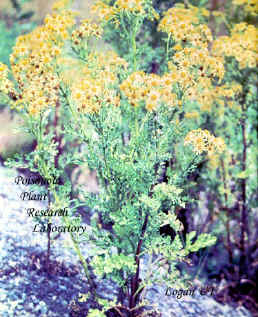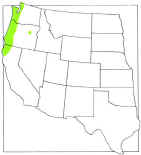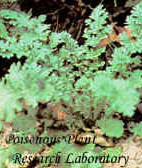 Tansy ragwort is a weedy, biennial plant that infests woodlands, pastures, and hayfields of the coastal northwest United States. It is generally unpalatable to livestock and, therefore, is eaten only when other food is scarce or when it cannot be avoided as in hay, ensilage, and lush pastures. It is toxic to all classes of livestock but most toxic to cattle and horses. At doses likely to be ingested, it causes a chronic liver disease that is seen as a cirrhosis-like hepatic degeneration. Affected animals generally die within several weeks or months after the tansy ragwort has been eaten. As this is often after the contaminated hay or feed is not available for inspection, it is difficult to definitively diagnose tansy intoxication and death may be attributed to other causes. Tansy ragwort is a weedy, biennial plant that infests woodlands, pastures, and hayfields of the coastal northwest United States. It is generally unpalatable to livestock and, therefore, is eaten only when other food is scarce or when it cannot be avoided as in hay, ensilage, and lush pastures. It is toxic to all classes of livestock but most toxic to cattle and horses. At doses likely to be ingested, it causes a chronic liver disease that is seen as a cirrhosis-like hepatic degeneration. Affected animals generally die within several weeks or months after the tansy ragwort has been eaten. As this is often after the contaminated hay or feed is not available for inspection, it is difficult to definitively diagnose tansy intoxication and death may be attributed to other causes.
Where and When It Grows
Tansy ragwort grows in areas with over 50 cm of rainfall annually; however, it could possibly grow in heavily irrigated locations with less rainfall. In the United States, tansy ragwort occurs principally in coastal Washington, Oregon, northern California, and in the New England States, but has been reported in localized spots in inland Washington and Oregon. The rapid spread of the plant has been slowed due to the development of biological control procedures. 
Mature tansy ragwort may grow 1.0-1.5 meters tall. It is sturdy stemmed, has a strong "weedy" odor, and produces great numbers of seed. The first year's growth, the rosette stage, is most toxic. Livestock grazing contaminated pastures often cannot avoid eating it as they graze good forage. Tansy ragwort often invades pastures and hayfields and may be found in any open uncultivated place. Rosette, flower, and seed stage plants may be found in the same pasture.  How It Affects Livestock How It Affects Livestock
Tansy ragwort contains pyrrolizidine alkaloids, which affect primarily the liver. Cells of the liver are slowly killed and prevented from regenerating to replace damaged tissues resulting in gradual scarring and replacement with connective tissue. Whether an animal survives depends upon the amount and rate of damage. Some animals survive for 6 months or longer after they have ingested a lethal amount of plant. During this latent period they may show no outward symptoms or signs. Later, often without additional exposure to tansy, they may become lethargic, fill with fluid in the abdominal cavity, and die within 2 to 4 days. Such animal may develop central nervous system disease seen as impaired vision and incessant stumbling. The onset of symptoms may be precipitated by other stresses such as pregnancy, lactation or poor nutrition. Often the animal's death is mistakenly attributed to other causes. Animals eating 5 percent or more of their total daily diet of prebloom tansy ragwort for periods exceeding 20 consecutive days can be expected to die within a 6-month period. Signs and Lesions of Poisoning Signs may not appear until 6 or more months after the plant is ingested, and they
may vary, depending on the amount of plant eaten and the rate at which it was
eaten Lethargy and loss of interest in food Crustiness around eyes and nose. Eyes may also be red and watery, especially in
bright sunlight There may be diarrhea or constipation Weakness as manifest by wobbling and dragging rear feet Animals may wander aimlessly and appear to be blind and may become belligerent Cattle may develop a pig-like odor that has a somewhat sweetish quality The abdominal cavity may fill with fluid up to several gallons (ascites), and death
may occur within a few days after symptoms appear Liver cirrhosis (necrosis and fibrosis) and bile duct proliferation Gastroenteritis How to Reduce Losses
When symptoms of tansy ragwort poisoning appear, it is too late to save the animal; thus, the best preventative is avoidance of the plant. Young animals are more easily poisoned than mature animals. Pastures for horses and cattle with over 5 percent tansy ragwort content should be avoided until the tansy ragwort has been controlled. Tansy ragwort can be suppressed by grazing with sheep or goats. Hay and ensilage contaminated with tansy ragwort especially should be avoided as animals cannot sort out the tansy ragwort as in the pasture situation. In cultivated areas tansy ragwort can be controlled by cultivation. Research results show that tansy ragwort can be controlled with 2,4-D (low volatile ester or emulsifiable acid) at 0.5-1.0 kg pounds active ingredient per acre, or by dicamba at 0.23 to 0.5 kg active ingredient per acre. Tansy ragwort should be sprayed in the rosette stage. Both herbicides will injure or kill legumes. Follow all precautions for handling herbicides. |

 How It Affects Livestock
How It Affects Livestock
 Tansy ragwort is a weedy, biennial plant that infests woodlands, pastures, and hayfields of the coastal northwest United States. It is generally unpalatable to livestock and, therefore, is eaten only when other food is scarce or when it cannot be avoided as in hay, ensilage, and lush pastures. It is toxic to all classes of livestock but most toxic to cattle and horses. At doses likely to be ingested, it causes a chronic liver disease that is seen as a cirrhosis-like hepatic degeneration. Affected animals generally die within several weeks or months after the tansy ragwort has been eaten. As this is often after the contaminated hay or feed is not available for inspection, it is difficult to definitively diagnose tansy intoxication and death may be attributed to other causes.
Tansy ragwort is a weedy, biennial plant that infests woodlands, pastures, and hayfields of the coastal northwest United States. It is generally unpalatable to livestock and, therefore, is eaten only when other food is scarce or when it cannot be avoided as in hay, ensilage, and lush pastures. It is toxic to all classes of livestock but most toxic to cattle and horses. At doses likely to be ingested, it causes a chronic liver disease that is seen as a cirrhosis-like hepatic degeneration. Affected animals generally die within several weeks or months after the tansy ragwort has been eaten. As this is often after the contaminated hay or feed is not available for inspection, it is difficult to definitively diagnose tansy intoxication and death may be attributed to other causes.
